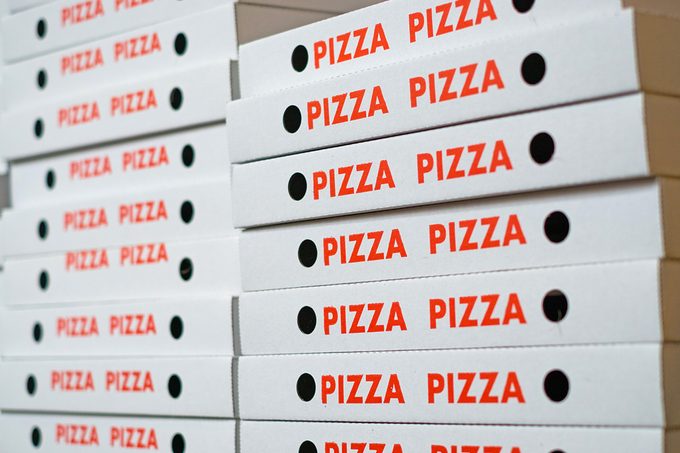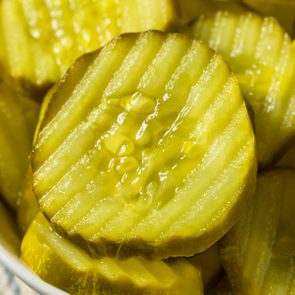Those little holes are more important than you might think

Here’s What the Holes in Pizza Boxes Are For

Have you ever thought about the strange things that we just accept as totally normal? Like, for example, that we can join the army at 18 years old, but we can’t rent a car until we’re 25? Or the fact that we show appreciation or joy by just slapping our hands together really hard (aka clapping)? These facts, when you think too hard about them, only seem to become more bizarre.
Another to add to the list: When we get pizza as takeout or delivery, the pizza box has holes in it, even though we want it to stay hot the whole way home. What’s the deal? We spoke to a pizza expert to learn exactly what those holes are for and where they came from. Read on to find out why they have the power to make or break your entire pizza experience.
Get Reader’s Digest’s Read Up newsletter for more common curiosities, humor, travel, tech and fun facts all week long.
Why do pizza boxes have holes in them?

In short, the holes are to ensure that the pizza arrives at its destination in the same state (or as close as possible) as it was when it came out of the oven. Here’s how the holes work that magic.
Allowing steam to escape
This is the main role of the holes in the sides of the pizza box. “A hot pizza continues to emit steam even after it leaves the oven,” explains Gregorio Fierro, a master instructor at Scuola Italiana Pizzaioli and the owner and president at restaurant consultancy Conspersa Enterprises. “If that pizza is put into the box the moment it comes out, that steam will be trapped in the box and make the pizza soggy.” That’s the last thing you want: a slice of pizza that droops the second you pick it up, sending all the tasty cheese and toppings sliding to the floor.
“We try and encourage our pizzerias to let the pizza sit on a screen for a few moments before it’s boxed, but even with that, it is better for the restaurant to open the vents so that it vacates the additional steam and stays crisp,” adds Fierro.
Keeping the pizza warm
Pizza makers don’t want the pizza to lose its firmness or crispiness, but they also don’t want it to get cold before it can be eaten. That’s why the holes are small and on the sides of the box, instead of large and on top. Enough of the heat from the pizza is trapped to ensure it stays warm, but the holes allow some steam to escape to maintain the texture.
When did pizza places start using boxes like this?
“The current style box is commonly attributed to Domino’s Pizza founder Tom Monaghan, who was looking for a sturdier way to deliver a stack of pizzas at a time,” says Fierro. “He worked with a paper company, Triad, to create what is known as the Michigan box.” The original design, which was developed in the 1960s, didn’t have the steam holes on the sides. “The vents were actually hand-cut by some of the more knowledgeable pizza operators if they knew their pizza was going to travel,” Fierro explains. “Somewhere along the way, the cut-outs were punched out at the factory.”
Prior to the development of the folding, corrugated pizza box we know and love today, there were different ways that people transported pizza. “In Naples, Italy, where pizza was born, there was a copper drum–shaped device called a stufa carried by itinerant salespeople that allowed pizza to be eaten outside of pizzerias,” Fierro says. “The original U.S.-based delivery system was a bit more primitive. Pizzas were rolled and then wrapped in paper. There was also a lot of pizza sold in paper bags. In fact, there are still parts of the country that sell slices slipped into a paper bag.”
Believe it or not, pizza didn’t start being packed and delivered in today’s boxes until after World War II, when its popularity really exploded. “People began experimenting with larger versions of a typical paper board pastry-style box,” Fierro adds. “Certainly better than a bag, but it did not allow for the pizza to travel undamaged and [stay] warm.”
Then in the ’60s, Domino’s started using the Michigan box, and the rest is history. “Sixty years later, this is more or less the same box design most pizza companies still use today,” said host Zachary Crockett on a 2023 episode of the podcast The Economics of Everyday Things all about pizza boxes.
Do all pizza boxes sport these holes?
Yes and no. “At this point, most boxes have the punch cuts, but they need to be pushed open manually,” Fierro says. This likely has to do with another key consideration that goes into pizza box design: the structural integrity of the box.
If the holes came punched out all the way or any larger than they are, there could be a risk of the boxes collapsing in on the pizzas if many were stacked on top of one another. That was something the original designer kept in mind, and the reason that this design has stuck around.
Are certain types of pizza better in boxes without holes?
In a word, no. Whether you’re ordering a New York–style, Chicago deep dish, Detroit-style, Sicilian or Greek pizza, you’re going to see holes in the pizza box. “Most of the boxes, despite their size, have the same characteristics,” says Fierro. Indeed, even if a pizza isn’t meant to be crispy, you still want the crust to stay firm and not soggy to make it easier and more enjoyable to eat—and a pizza box with holes is the best way to achieve that delectable goodness.
RELATED:
- Here’s Why Ice Cubes in Restaurants Have Holes
- This Is the Real Reason Why McDonald’s Straws Are So Wide
- Here’s Why Takeout Sushi Always Comes with Plastic Grass
About the expert
|
Why trust us
At Reader’s Digest, we’re committed to producing high-quality content by writers with expertise and experience in their field in consultation with relevant, qualified experts. We rely on reputable primary sources, including government and professional organizations and academic institutions as well as our writers’ personal experiences where appropriate. We verify all facts and data, back them with credible sourcing and revisit them over time to ensure they remain accurate and up to date. Read more about our team, our contributors and our editorial policies.
Sources:
- Gregorio Fierro, master instructor at Scuola Italiana Pizzaioli and the owner and president of Conspersa Enterprises; email interview, June 2025
- Freakonomics: “The Economics of Everyday Things: Pizza Boxes”



